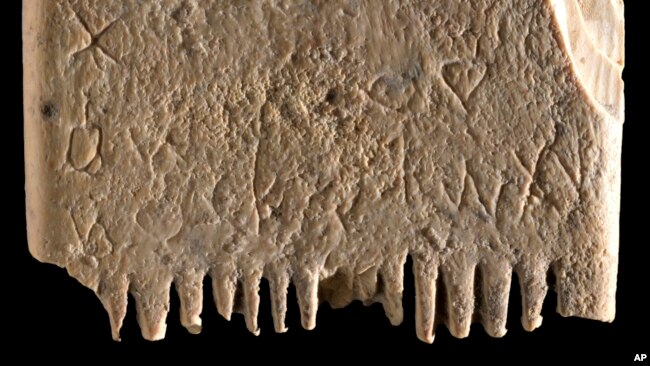Israeli【izréili】:イスラエルではありません!!
カタカナ記述は好きではありませんが。【イズレイリィ】
VOAで英語を学びましょう!!
イスラエルで最古のアルファベットの文章を発見(和訳)
Researchers Might Have Found Oldest Alphabetic Sentence in Israel
Nov.12,2022
イスラエルの研究者が、カナン語で書かれた最古の全文と思われる古代のcomb櫛を発見しました。この発見は、Jerusalem Journal of Archaeologyに最近掲載された研究論文に記載されています。
この文章は3,700年前のものである可能性があります。この文章は、シラミと呼ばれる小さな虫を取り除くために髪やひげをとかすようにと人々に伝えています。文章は17文字で構成されており、次のように書かれています:「このtusk牙が髪と髭のシラミを根絶しますように。」
専門家らは、この発見は、約3,800年前に発明されたカナン人のアルファベットの最古の使用方法の一部について情報を与えるものであると言います。カナン文字は、ヘブライ語、ギリシャ語、ラテン語、キリル文字など、後のアルファベット体系の基礎となったものです。
この文字の題材から、当時の人々は日常生活でシラミに悩まされていたことがうかがえます。研究者によると、櫛には頭シラミの顕微鏡的な証拠も見つかっていると言います。
この櫛は2016年にイスラエル南部で初めて発見されました。しかし、イスラエルのヘブライ大学の教授がそこに書かれた小さな文字に気づいたのは、昨年末のことでした。
主席研究員であるヘブライ大学のヨセフ・ガーフィンケル氏は、AP通信の取材に答えました。彼は、カナン文字を記した古代の品物は長年にわたって数多く発見されているが、完全な文章が発見されたのはこの櫛が初めてだと言います。
ガーフィンケル氏は、それ以前に発見されたものには、ほんの数文字、あるいはあちこちに単語があっただけだと言います。このような短い文字では、カナン人の生活についてさらに研究する余地はあまりありません。「十分な資料がなかったのです」と彼は言います。
この発見は、古代の時代についての議論を開くものだとガーフィンケル氏は付け加えます。彼は、この文章が古代都市の宮殿と神殿のエリアにある象牙の櫛から見つかったことが重要であると述べています。また、その文章がひげについて述べていることも注目すべき点です。ガーフィンケル氏は、裕福な男性だけが読み書きができたことを示唆しているのではないかと述べています。
「これは非常に人間的な文章です」とガーフィンケル氏は言います。「それは人々が本当に変わらなかったし、シラミも本当に変わらなかったことを我々に示しています。」
カナン人は、現代のヘブライ語、アラビア語、アラム語に関連する古代セム語系の言語を話していました。カナン人は地中海東部沿岸の土地に住んでいました。彼らは初めて知られたアルファベットの文字体系を開発したと考えられています。
この完全な文章は、カナン人が初期の文明の中で、文字の使用において際立っていたことをさらに示唆しています。「最も古いphas段階でも完全な文章があったことを示しています」とガーフィンケル氏は付け加えています。
彼は、専門家がエジプトのシナイ半島で発見された古代カナン人のアルファベットと比較することによって、この文字が3,700年前に作られたものであると言っています。このような文字は3,900年から3,700年前に遡ります。
しかし、この研究では、櫛の炭素年代測定は正確な年代を示すことができなかったと述べています。
オーストリアの考古学者でこの時代の専門家であるフェリックス・ヘフマイヤー氏は、この研究発表には参加していませんが、この年代測定の方法は十分でないと述べます。
「現在知られている初期のアルファベットinscriptions碑文には、確実な年代を示すものが少ないのです」と彼は言います。しかし、彼はこの発見が重要であると付け加えています。
ヘフマイヤー氏は、「17の文字が一つの物体に保存されていることは、間違いなく注目に値します」と述べます。
Researchers Might Have Found Oldest Alphabetic Sentence in Israel
Israeli researchers have found an ancient comb that has what is likely the oldest known full sentence written in Canaanite. The discovery was described in a study published recently in the Jerusalem Journal of Archaeology.
The writing could be 3,700 years old. It tells people to comb their hair and beards to remove small insects known as lice. The sentence contains 17 letters that read: “May this tusk root out the lice of the hair and the beard.”
Experts say the discovery gives information about some of the earliest use of the Canaanite alphabet, invented around 3,800 years ago. The Canaanite alphabet was the base for later alphabetic systems, such as Hebrew, Greek, Latin and Cyrillic.
The subject of the writing suggests that people had trouble with lice in everyday life at the time. Researchers said they have even found microscopic evidence of head lice on the comb.
The comb was first found in 2016 in southern Israel. But it was only late last year when a professor at Israel’s Hebrew University noticed the tiny words written on it.
The lead researcher, Yosef Garfinkel of Hebrew University, spoke to The Associated Press. He said that while many ancient objects with Canaanite writing have been found over the years, the comb has the first complete sentence to be discovered.
Garfinkel said earlier findings contained just a few letters, maybe a word here and there. Such short pieces of writing did not leave much room for further research on the lives of the Canaanites. “We didn’t have enough material,” he said.
The find opens up the debate about the ancient time period, Garfinkel added. He said it was important that the sentence was found on an ivory comb in the ancient city’s palace and temple area. It also was notable that the writing spoke of a beard. Garfinkel said it could suggest that only wealthy men were able to read and write.
“It is a very human text,” Garfinkel said. “It shows us that people didn’t really change, and lice didn’t really change.”
Canaanites spoke an ancient Semitic language that is related to modern Hebrew, Arabic and Aramaic. The Canaanites lived in the lands along the eastern Mediterranean. They are believed to have developed the first known alphabetic system of writing.
The complete sentence further suggests that Canaanites stood out among early civilizations in their use of the written word. “It shows that even in the most ancient phase there were full sentences” Garfinkel added.
He said experts dated the script to 3,700 years ago by comparing it to the ancient Canaanite alphabet found earlier in Egypt’s Sinai Desert. Such writing dates back between 3,900 and 3,700 years.
But, the study noted, carbon dating of the comb failed to show its exact age.
Austrian archaeologist Felix Höflmayer, an expert on the period who was not part of the publication, said the method of dating was not good enough.
“There are just not enough securely dated early alphabetic inscriptions currently known,” he said. But, he added the discovery was important.
“Seventeen letters preserved on a single object is definitely remarkable,” Höflmayer said.
Words in This Story
comb – n. a flat object with a row of thin teeth that is used for making hair neat
tusk – n. a very long, large tooth that sticks out of the mouth of an animal (such as an elephant, walrus, or boar)
alphabet – n. the letters of a language arranged in their usual order
professor – n. a teacher especially of the highest rank at a college or university
phase –n. a period that is part of a series of events showing a process of development
inscription – n. words that are written on or cut into a surface
